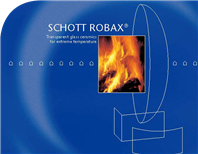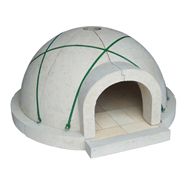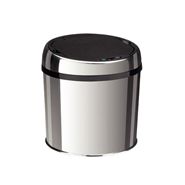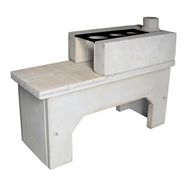Schott Robax
vidros especiais
vidros
vidro para lareira
vidro resistente ao fogo
vidros para churrasqueira
vidro cerâmica
14
4.
The following technical information is generally valid for ROBAX®. Unless otherwise
indicated, the data provided are guide figures. Values for which no generally
applicable measurement method exists or alternatively which are not defined in
a generally applicable manner (for example by means of a standard), are specified
and explained.
approx. 2.6 g/cm3 (at 25 °C)
E approx. 93 x 103 MPa (at 25 °C)
The test is carried out in accordance with ASTM 1259-01. A tensile or compressive
load is applied to a rod-shaped test piece to produce a change in length, the
amount of which depends on the material and load. The modulus of elasticity
describes the relationship between the tension and the material’s change in
length.
4.1 General information
4.2 Mechanical properties
4.2.1 Density
4.2.2 Modulus of elasticity/
Young’s modulus
4. Technical properties – quality
in numbers, information and facts
In addition to an attractive appearance, ROBAX® is distinguished in particular
by its “inner” values. Whether mechanical, thermal, chemical, or optical
properties – the transparent glass ceramic meets even the highest
requirements with a flourish.
Schott Robax
vidros especiais
vidros
vidro para lareira
vidro resistente ao fogo
vidros para churrasqueira
vidro cerâmica
15
4.
μ approx. 0.25
The test is carried out in accordance with ASTM 1259-01. A mechanical stress
applied longitudinally produces both an increase in length and lateral contraction.
As the length changes, so do the dimensions of the piece at right angles to the
load.
bB approx. 35 MPa
The test is carried out in accordance with DIN EN 1288 T5, with the surface in
its normal condition of use as encouraged in practice.
Comments on impact resistance are only possible with knowledge of the specific
application. Of particular importance here are application-specific standards as
regards strength requirements. Nominal value on request.
Indications of the strength of glass and glass ceramic must take into account
the special properties of these materials.
In the technical sense, glass and glass ceramic are “ideally elastic”, brittle
materials which exhibit no tendency to flow. When they come into contact
with materials of the same hardness, this causes surface damage in the form
of fine nicks and cracks. When glass and glass ceramic are subjected to a
mechanical load, the build-up of critical stress at the points of such nicks and
cracks cannot be relieved by plastic flow, as is possible with such materials as
metals.
The consequence of this behavior is that the structurally based high strength
of glass and glass ceramic (≥ 104 N/mm2) is irrelevant in practice. It is reduced
by the effect of unavoidable surface defects (in the case of unprotected surfaces)
to a practical value of approx. 20 to 200 N/mm2 bending strength – depending
on the surface state and test conditions.
The strength of glass and glass ceramic is therefore not a material constant (as
for example its density), but is dependent on the following criteria:
• finish condition of the panel (incl. edge finish, boreholes, etc.)
• usage condition (type and distribution of surface defects)
• time-related conditions or alternatively the duration of the effective load
• surrounding conditions (corrosive substances, e.g. hydrofluoric acid)
• the area subject to load as well as the thickness of the panel
• the type of panel in installation
The strength is also subject to a statistical distribution in accordance with the
type and distribution of the surface defects.
4.2.3 Poisson’s ratio
4.2.4 Bending strength
4.2.5 Impact resistance
4.2.6 Comments on mechanical
properties








 Forno a lenha Iglú Chaminé central
Forno a lenha Iglú Chaminé central
 Lixeira automática com sensor
Lixeira automática com sensor
 Fogão a lenha Modelo Fazenda
Fogão a lenha Modelo Fazenda